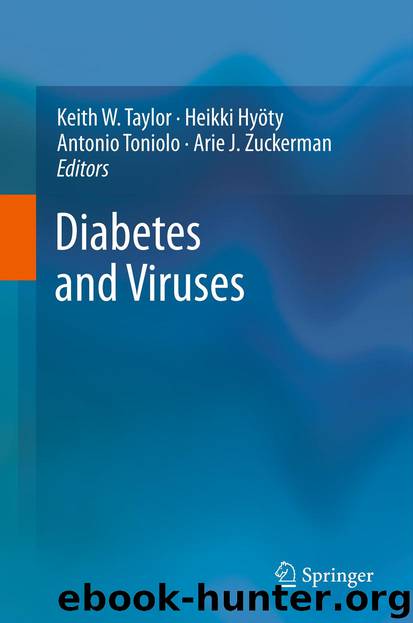Diabetes and Viruses by Keith Taylor Heikki Hyöty Antonio Toniolo & Arie J. Zuckerman

Author:Keith Taylor, Heikki Hyöty, Antonio Toniolo & Arie J. Zuckerman
Language: eng
Format: epub
Publisher: Springer New York, New York, NY
Temporal Association of Rotavirus Infection with Islet Autoimmunity
Longitudinal studies of children at risk for type 1 diabetes provide the opportunity to investigate a relationship between markers of RV infection and islet autoimmunity. In the Australian BabyDiab Study (Couper et al. 1999), sera from children followed 6 monthly from birth were tested for islet autoantibodies and for IgG and IgA antibodies to RV (Honeyman et al. 2000b). A specific and highly significant association was found between RV seroconversion and the first appearance of or an increase in the concentration of autoantibodies to either IA-2 (in 86%), insulin (in 62%), and/or GAD65 (in 50%). Subsequently, this relationship was not found in at-risk children in Finland (Blomqvist et al. 2002). The Finnish study differed however in that it did not test for antibodies to a RV G3 serotype found commonly in humans, but rather to a G6 serotype, an uncommon cause of infection in humans. Moreover, the Finnish study did not test for RV IgA which although short-lived is the most important protective antibody. It is therefore possible that RV infections were missed. Indeed, in a later study (Makela et al. 2004), the same senior investigators found that some RV infections could only be defined serologically by a rise in IgA assayed now on both G1 and G6 serotypes. Children in the Finnish study were selected for HLA-DQ susceptibility to type 1 diabetes, whereas the Australian children were selected by relationship to a first-degree relative with type 1 diabetes. Virus infection might be more important in driving islet autoimmunity in individuals who lack the strongest HLA susceptibility genes. This is suggested by the finding that at the onset of type 1 diabetes, children positive for enteroviral RNA were less likely to have DR3-DQ2 haplotypes (OR 0.46) than those without enteroviral RNA, and non-DR3, DR4 children had a higher frequency of enteroviral RNA positivity (OR 2.52) (Craig et al. 2003). Further studies are needed to resolve this issue. In ten children without a family history of type 1 diabetes who were admitted to hospital for acute RV infection, acute and convalescent sera were tested for autoantibodies to insulin, GAD65 and IA-2, thyroid peroxidase and nuclei. Three patients had antibodies to both GAD65 and IA-2, but not to insulin, thyroid peroxidase, or nuclei (Honeyman et al. 2000b). Although only a small sample, a frequency of 30% for two autoantibodies greatly exceeds that of 0.1% in the population at large.
Download
This site does not store any files on its server. We only index and link to content provided by other sites. Please contact the content providers to delete copyright contents if any and email us, we'll remove relevant links or contents immediately.
| Administration & Medicine Economics | Allied Health Professions |
| Basic Sciences | Dentistry |
| History | Medical Informatics |
| Medicine | Nursing |
| Pharmacology | Psychology |
| Research | Veterinary Medicine |
Tuesdays with Morrie by Mitch Albom(4690)
Yoga Anatomy by Kaminoff Leslie(4306)
Science and Development of Muscle Hypertrophy by Brad Schoenfeld(4089)
Bodyweight Strength Training: 12 Weeks to Build Muscle and Burn Fat by Jay Cardiello(3913)
Introduction to Kinesiology by Shirl J. Hoffman(3725)
How Music Works by David Byrne(3187)
Sapiens and Homo Deus by Yuval Noah Harari(2987)
The Plant Paradox by Dr. Steven R. Gundry M.D(2547)
Churchill by Paul Johnson(2506)
Insomniac City by Bill Hayes(2497)
Coroner's Journal by Louis Cataldie(2432)
Hashimoto's Protocol by Izabella Wentz PharmD(2331)
The Chimp Paradox by Peters Dr Steve(2297)
The Universe Inside You by Brian Clegg(2097)
Don't Look Behind You by Lois Duncan(2080)
The Immune System Recovery Plan by Susan Blum(2027)
The Hot Zone by Richard Preston(1983)
Endure by Alex Hutchinson(1964)
Woman: An Intimate Geography by Natalie Angier(1882)
